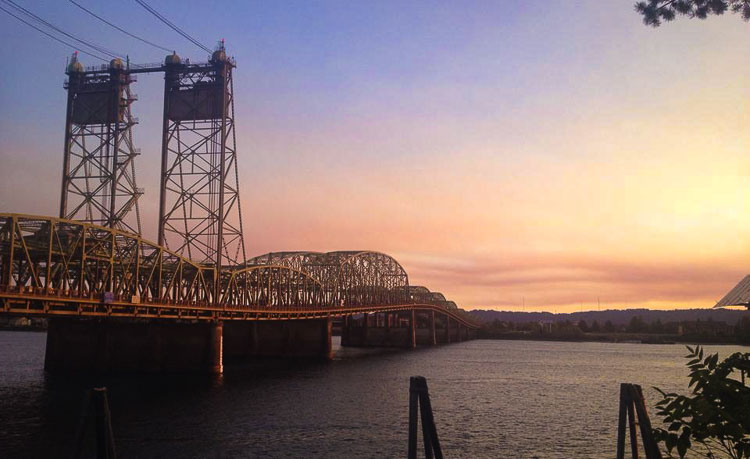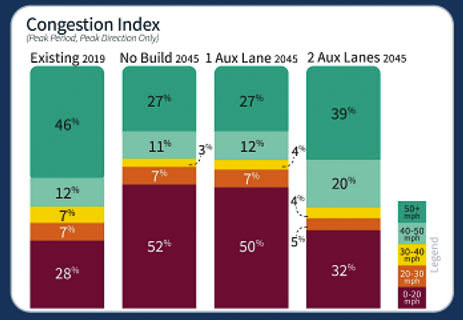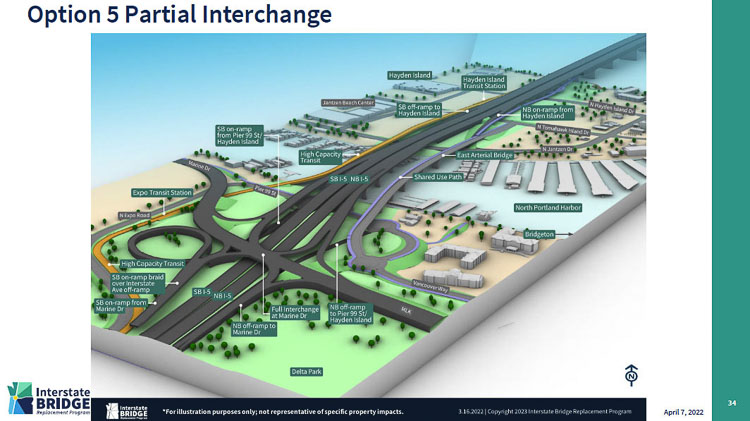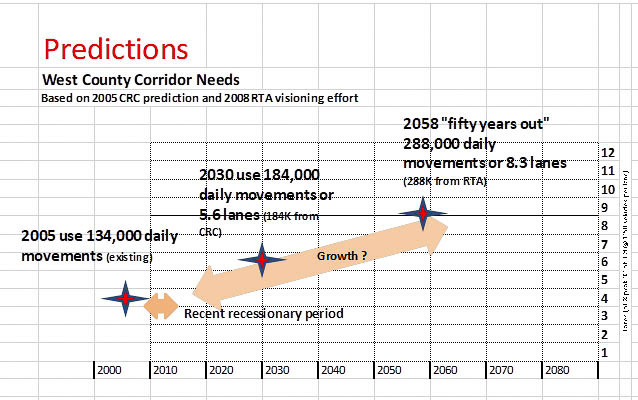
Under the proposal, drivers could be stuck in traffic twice as long as they are today
John Ley
For Clark County Today
The Interstate Bridge Replacement Program (IBR) team revealed their recommendation for the project Thursday morning to the members of the Executive Steering Group (ESG). Their recommendations include having only one auxiliary lane on the bridge versus two. They had previously informed citizens they would only have three through lanes in each direction, matching current bridge capacity.
They are also recommending partial interchanges on Hayden Island, which will reduce the footprint over the island compared to what full interchanges would create. Light rail had been previously revealed as the choice for transit. They will propose three new transit stations into Vancouver, with the MAX Yellow line ending at Evergreen Blvd. next to the I-5 freeway in Vancouver.
Variable rate tolling is recommended for the project, according to Administrator Greg Johnson. The higher tolling charges during rush hour may help reduce traffic and demand by influencing drivers to abandon their vehicles and instead commute via light rail or other options. Yet several members of the ESG expressed concerns about tolls harming citizens with lower incomes.
Johnson touted the recommendation as “the largest investment in active transportation and high capacity transit in the region’s history.” Previously the IBR team told legislators that building the previous Columbia River Crossing (CRC) would cost between $3.2 billion and $4.8 billion.

The revelation by Johnson and his team is that they are recommending less than what the CRC offered. The IBR will have only one auxiliary lane, whereas the CRC had two. Auxiliary lanes are for merging and weaving either on to, or off of, the existing freeway lanes. Hayden Island will only have partial interchanges whereas they had full interchanges in the prior project.
Vancouver Mayor Anne McEnerny-Ogle personally supports the choice of light rail as the transit option. She encouraged the IBR team and her colleagues to stay focused on “climate and equity goals,” noting Vancouver’s “net zero” greenhouse gas (GHG) emissions policy for 2040.
Metro President Lynn Peterson applauded the recommendation, calling the IBR proposal “right sized.” She noted the failed Columbia River Crossing (CRC) had 17 lanes versus the IBR proposal which has three through lanes and one auxiliary lane in each direction. Portland city commissioner Jo Ann Hardesty noted the “marginal increase in auto capacity,” as she applauded the smaller number of lanes and the selection of light rail.
Previous information provided by the IBR staff indicates that after spending up to $5 billion, commuters and freight haulers will be stuck in congested traffic twice as long in 2045 as they are today.
Lynn Valenter, co-chair of the IBR’s Community Advisory Group (CAG), said she was overwhelmed at the “less than stellar improvement” in morning commute times. “Disappointment is the mildest word I can use,” she said.
Morning travel times will double on I-5 according to the IBR team. Presently, it takes 29 minutes to travel from the I-205 interchange in Vancouver to the I-405 interchange in Portland. That will take 60 minutes in 2045, with the addition of one auxiliary lane. Similarly, it currently takes 16 minutes to travel from 99th Street in Vancouver to Victory Blvd. in Portland. It will take 33 minutes in 2045 with the project’s recommendation.
A different perspective indicates that 50 percent of vehicles will be traveling at zero to 20 miles per hour during peak travel times, with only one auxiliary lane. Presently, 28 percent of vehicles are traveling that slow during rush hour commutes.
John Willis, IBR deputy program manager, summarized feedback provided by the Community Advisory Group. “We really want to maximize the capacity and minimize congestion,” he reported. Earlier surveys reported 78 percent of Clark County residents prioritized saving time and reducing traffic congestion.
Their most recent survey respondents tended to favor the two auxiliary lanes by a slim majority, according to Willis. Clark County residents were more likely to select the two auxiliary lane option, and Oregon residents were a bit split with the two auxiliary lane option slightly more preferred by those living outside of the Portland city limits.
“When looking at the whole program combined with transit, one auxiliary lane seemed appropriate,” he said. “Two auxiliary lanes address congestion and provided good value in that it may not cost much more to add a second aux lane, in the overall program costs, but we do look at the scale of the project.”
Julianna Marler of the Port of Vancouver indicated her conversations with the freight community said “make sure we’re relieving congestion.” That isn’t happening as travel times in the morning double, and half of vehicles traveling during any rush hour would be traveling zero to 20 mph according to an IBR graphic.
“Don’t stop us” was the plea of one freight hauler, it was reported.

Citizens might compare this proposal with what ODOT is doing on I-205 at the Abernethy Bridge. Because ODOT is adding one more through lane in each direction (a 50 percent capacity increase), travel times will be significantly reduced on I-205 according to ODOT. “The analysis found that drivers could see a 50 percent decrease in afternoon travel time and a 25 percent decrease in the morning,” ODOT officials said.
“Travel time (on transit) – this was not a surprise, but travel time ranked as the most important transit priority as part of that feedback,” said Willis. Yet the choice of light rail contradicts that priority. The MAX Yellow Line travels an average of 14 miles per hour, much slower than bus and vehicle travel. The IBR had conducted an opinion poll which indicated a majority of people on both sides of the river supported light rail as the transit mode.
“The capacity on light rail transit options allows the program to maximize trips, provides more competitive travel time and greater access to jobs and bus rapid transit alone,” said Willis. Yet TriMet only runs its two-car light rail trains at 15-minute headways, which can only carry just over 1,000 people each hour. Over 140,000 vehicles cross the Columbia River on an average weekday.
“Light rail is more competitive for that federal funding we are looking for as a component of the overall program,’’ Willis told the ESG.
C-TRAN CEO Shawn Donaghy questioned that statement about the Federal Transit Administration (FTA) preferring to fund light rail over bus rapid transit (BRT). “There really is no one mode that is more effective at getting public transit funding than the other,” he said.
“I just want to make a comment about something that was mentioned in the transit portion, which is the statement that light rail has the ability to (get) federal funding better than BRT does,” Donaghy said. “I would say that’s very specific to this project, and not necessarily a function of FTA funding, I think you’re seeing the FTA move a lot more toward BRT projects, because they’re cheaper. They’re a little more effective on certain aspects of other transit systems, or even our transit system, for example.”
Johnson indicated his team will have a recommended cost estimate and financial plan by the end of the year. He spoke about the Washington legislature providing $1 billion in funding and expects Oregon will do the same next year. He mentioned “how much we can leverage in tolling” will be determined, before approaching the federal government for its bridge contribution.
The IBR team will meet with Coast Guard officials later this month. They have already requested permission to design a bridge with 116 feet of clearance, much lower than several up river users need. Johnson spoke about “mitigation or avoidance,” without mentioning the $86.4 million in mitigation required to be paid in the CRC proposal. He mentioned extensive feedback from marine users asking to “make sure we don’t hinder river travel.”
The 16-members of the Bi-state Bridge Committee of legislators will meet on Friday. They will receive a similar briefing and provide feedback.
At the end of the meeting, all members were asked by the IBR team the following question. “Are you ready to take this Program Recommendation to your Boards, Councils, and Commissions to get feedback?”
Everyone said “yes.” That was not asking for approval or disapproval of the recommendation. The question appeared to be framed in a manner to guarantee a “yes” vote.
Oregon Gov. Kate Brown had promised traffic projection studies would be done prior to a proposal being made. That has not happened.

Transportation architect Kevin Peterson had scrutinized the same CRC traffic data the IBR is using. He forecasts that by 2030, two years prior to the completion of the bridge, I-5 would have about 180,000 daily vehicle movements, creating a need between five and six lanes in each direction. By 2045, he saw the need for between seven and eight lanes in each direction.
It would seem any “data driven” process would have to accommodate those numbers and projections, or prove they are wrong. However, the IBR team is informing citizens that after spending up to $5 billion transportation dollars, they will be stuck in traffic congestion even longer than they are today.




